CHSL (10+2) Model Papers Mock Test -2 “Arithmetic”
CHSL (10+2) Model Papers Mock Test -2 “Arithmetic”
1. The area of a circle is 38.5 sq. cm. Its circumference (in cm) is :

(a) 22
(b) 24
(c) 26
(d) 32
2. The breadth of a rectangular hall is three-fourths of its length. If the area of the floor is 768 sq. m. then the difference between the length and breadth of the hall is
(a) 8 metres
(b) 12 metres
(c) 24 metres
(d) 32 metres
3. A metallic hemisphere is melted and recast in the shape of a cone with the same base radius (R) as that of the hemisphere. If H is the height of the cone, then
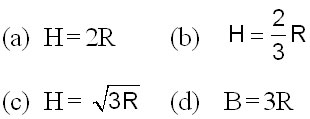
4. A conical vessle whose internal radius is 12 cm and height 50 cm is full of liquid. The contents are emptied into a cylindrical vessel with radius (internal) 10 cm. The height to which the liquid rises in the cylindrical vessel is
(a) 25cm
(b) 20cm
(c) 24cm
(d) 22cm
5. Two right circular cylinders of equal volume have their heights in the ratio 1 : 2. The ratio of their radii is

6. A and B can do a work in 12 days. B and C in 15 days. C and A in 20 days. If A, B and C work together, they will complete the work in:
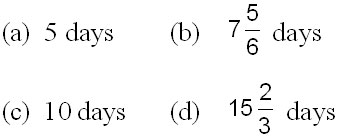
7.A is thrice as good a workman as B and therefore, able to finish a job in 60 days less than B. Working together they will do it in:

8. Two pipes A and B can fill a tank in 20 minutes and 30 minutes respectively. If both pipes are opened together, the time taken to fill the tank is:
(a) 50 minutes
(b) 12 minutes
(c) 25 minutes
(d) 15 minutes
9. If 6 men and 8 boys can do a piece of work in 10 days and 266 men and 48 boys can do the same in 2 days, the time taken by 15 men and 20 boys to do the same type of work will be:
(a) 5 days
(b) 4 days
(c) 6 days
(d) 7 days
10. A and B can do a work in 18 and 24 days respectively. They worked together for 8 days and then A left. The remaining work was finished by B in:

11. If a man walks 20 km at 5 km/hr, he will be late by 40 minutes. If he walks at 8 km per hr, how early from the fixed time will he reach?

12. A boy rides his bicycle 10km at an average speed of 12 km per hr and again travels 12 km at an average speed of 10 km per hr His average speed for the entire trip is approximately:
(a) 10.4km/hr
(b) 10.8 km/hr
(c) 11.0 km/hr
(d) 12.2 km/hr
13. A train 180 m long moving at the speed of 20 m/sec. over-takes a man moving at a speed of 10m/sec in the same direction. The train passes the man in
(a) 6 sec
(b) 9 sec
(c) 18 sec
(d) 27 sec
14. The distance between two cities A and B is 330 km. A train starts from A at 8 a.m. and travels towards B at 60 km/ hr Another train starts from B at 9 a.m. and travels towards A at 75 km/hr At what time do they meet?
(a) 10 a.m.
(b) 10 : 30 a.m.
(c) 11 a.m.
(d) 11 : 30 a.m.
15. In covering a certain distance, the speeds of A and B are in the ratio of 3 : 4. A takes 30 minutes more than B to reach the destination. The time taken by A to reach the destination is
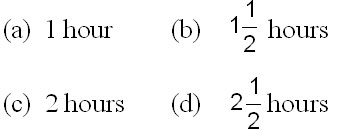
Directions : A survey of film watching habits of people living in 5 cities, I, II, III, IV and V is summarised below. The column
(a) gives percentage of film-watchers in each city who see only film a week. The column
(b) gives the total number of film-watchers who see more than one film per week. Read the table and answer question 16 and 20:
City (a) (b)
I 50 3200
II 30 3500
III 65 7000
IV 25 5400
V 80 2900
16. How many film-watchers in city II see only one film a week?
(a) 900
(b) 1500
(c) 1600
(d) 3200
17. Which city has the highest number of film-watchers who see only one film a week?
(a) I
(b) II
(c) III
(d) IV
18. The city with the lowest number of film-watcher is
(a) I
(b) II
(c) IV
(d) V
19. The city with the highest number of film-watchers is
(a) I
(b) V
(c) IV
(d) III
20. The total number of all filmwatchers in the five cities who see only one film a week is
(a) 31100
(b) 29500
(c) 28600
(d) 28300
Directions: Questions are based on the following bar graph. Read the graph and answer the questions.
21. What is the percentage increase in the gross traffic receipts in 1995-96 as compared to 1993-94?
(a) 33.9%
(b) 41.5%
(c) 20.7%
(d) 17%
22. If profit = gross traffic receipts – total expenditure, then in 1996-97, what percentage of gross traffic receipts is the profit made?
(a) 5.9%
(b) 6.4%
(c) 7.2%
(d) 8%
23. In which year was the profit as a percentage of gross traffic receipts the highest?
(a) 1997-98
(b) 1996-97
(c) 1995-96
(d) 1994-95
24. In order to make a profit of 10%. What should have been the gross traffic receipts (in Rs. crores) in 1994-95, total expenditure remaining the same?
(a) 5,667
(b) 5,876
(c) 6,444
(d) 7,667
25. By what amount (in Rs. crores) has the expenditure increased over the period 1993-94 to 1997-98?
(a) 4,100
(b) 3,900
(c) 3,850
(d) 3,700
26.
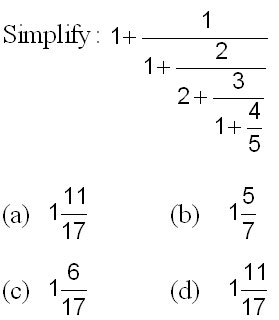
27.
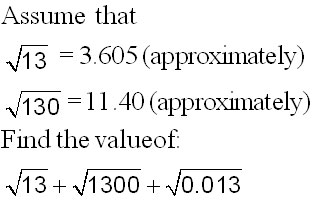
(a) 36,164
(b) 37,304
(c) 36,304
(d) 37,164
28. On simplification of

(a) 1
(b) 4
(c) 5
(d) 6
29.
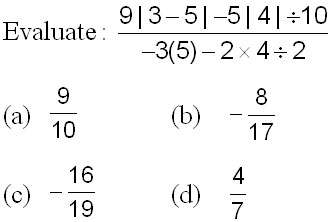
30. By how much does
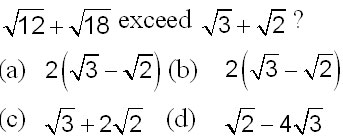
31.
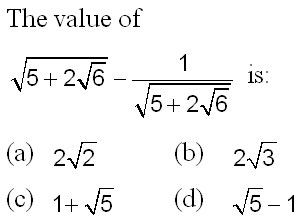
32. The value of (243)0.16× (243)0.04 is equal to:
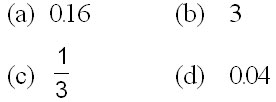
33. The simplification of gives:

(a) 0.01
(b) 0.001
(c) 0.1
(d) 0.02
34.

(a) 2
(b) 2.5
(c) 3
(d) 3.5
35. 5 – [4 – {3 – (3 – 3 – 6)}] is equal to:
(a) 10
(b) 6
(c) 4
(d) 0
36. If the square root of 841 is 29, then 0.00000841 is equal to :
(a) 0.029
(b) 0.0029
(c) 0.00029
(d) 0.29
37.
![]()
(a) 12
(b) 16
(c) 18
(d) 24
38. If a * b = 2a – 3b + ab, then 3 * 5 + 5 * 3 is equal to:
(a) 22
(b) 24
(c) 26
(d) 28
39. What is the square root of 0.09?
(a) 0.3
(b) 0.03
(c) 0.003
(d) 3.0
40.

(a) 52
(b) 54
(c) 58
(d) 512
41.
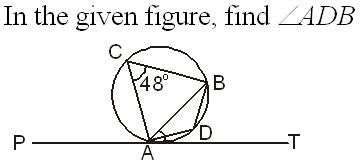
(a) 132°
(b) 144°
(c) 48°
(d) 96°
42. In the following figure, find x
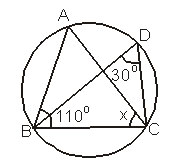
(a) 40°
(b) 25°
(c) 30°
(d) 45°
43.
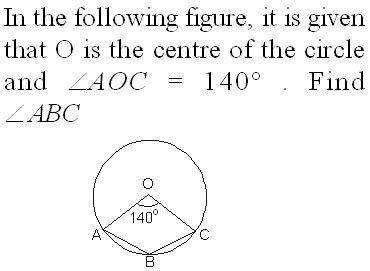
(a) 110°
(b) 120°
(c) 115°
(d) 130°
44. Find x in the given figure
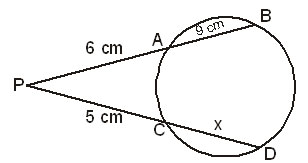
(a) 13 cm
(b) 12 cm
(c) 16 cm
(d) 15 cm
45.
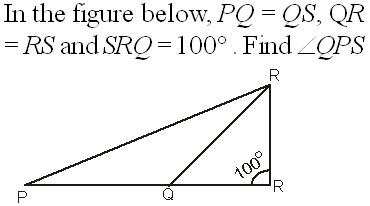
(a) 20°
(b) 40°
(c) 15°
(d) 735°
46. The following points (3a, 0), (0, 3b), (a, 2b) forms a
(a) straight line
(b) triangle
(c) equilateral triangle
(d) None of these
47. The points A(–1, 4), B(5, 2) are the vertices of a triangle of which C(0,–3) is centroid, then the third vertex C is
(a) 4, 15
(b) 4, –15
(c) –4, –15
(d) None of these
48.

(a) 60°
(b) 45°
(c) 30°
(d) None of these
49. Which of the following expression is a polynomial in two variables?
(a) x2 – 2xy + y2 – x + y
(b) x3 + y3 + z3 –1
(c) x2 + 3x + 2
(d) x2 – 2x2 + 3x + 5
50. The degree of the polynomial 2x3 – 5x2 + x – 3 is
(a) 2
(b) 3
(c) 1
(d) 0
ANSWERS
1.(I) 2.(l) 3.(l) 4. (c) 5. (a) 6. (c) 7. (b) 8. (b) 9. (b) 10. (b) 11. (c) 12. (b) 13. (c) 14. (c)
15. (c) , 16. (b) 17. (c) 18. (b) 19. (d) 20. (a) 21. (b) 22. (a) 23. (d) 24. (c) 25. (d) 26. (a)
27. (c) 28. (c) 29. (c) 30. (c) 31. (a) 32. (b) 33. (a) 34. (l) 35. (a) 36. (b) 37.(a) 38. (a)
39. (a) 40. (b) 41.(a) 42. (a) 43. (a) 44. (a) 45. (a) 46. (a) 47. (c) 48. (b) 49. (a) 50. (b)